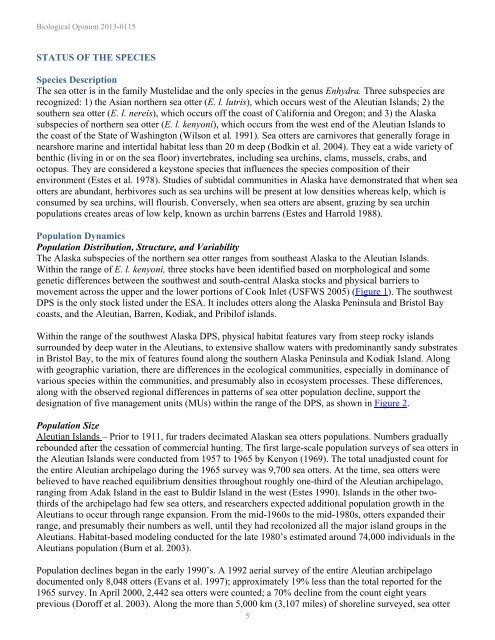United States Department of the Interior - U.S. Fish and Wildlife ...
United States Department of the Interior - U.S. Fish and Wildlife ...
United States Department of the Interior - U.S. Fish and Wildlife ...
Create successful ePaper yourself
Turn your PDF publications into a flip-book with our unique Google optimized e-Paper software.
Biological Opinion 2013-0115<br />
STATUS OF THE SPECIES<br />
Species Description<br />
The sea otter is in <strong>the</strong> family Mustelidae <strong>and</strong> <strong>the</strong> only species in <strong>the</strong> genus Enhydra. Three subspecies are<br />
recognized: 1) <strong>the</strong> Asian nor<strong>the</strong>rn sea otter (E. l. lutris), which occurs west <strong>of</strong> <strong>the</strong> Aleutian Isl<strong>and</strong>s; 2) <strong>the</strong><br />
sou<strong>the</strong>rn sea otter (E. l. nereis), which occurs <strong>of</strong>f <strong>the</strong> coast <strong>of</strong> California <strong>and</strong> Oregon; <strong>and</strong> 3) <strong>the</strong> Alaska<br />
subspecies <strong>of</strong> nor<strong>the</strong>rn sea otter (E. l. kenyoni), which occurs from <strong>the</strong> west end <strong>of</strong> <strong>the</strong> Aleutian Isl<strong>and</strong>s to<br />
<strong>the</strong> coast <strong>of</strong> <strong>the</strong> State <strong>of</strong> Washington (Wilson et al. 1991). Sea otters are carnivores that generally forage in<br />
nearshore marine <strong>and</strong> intertidal habitat less than 20 m deep (Bodkin et al. 2004). They eat a wide variety <strong>of</strong><br />
benthic (living in or on <strong>the</strong> sea floor) invertebrates, including sea urchins, clams, mussels, crabs, <strong>and</strong><br />
octopus. They are considered a keystone species that influences <strong>the</strong> species composition <strong>of</strong> <strong>the</strong>ir<br />
environment (Estes et al. 1978). Studies <strong>of</strong> subtidal communities in Alaska have demonstrated that when sea<br />
otters are abundant, herbivores such as sea urchins will be present at low densities whereas kelp, which is<br />
consumed by sea urchins, will flourish. Conversely, when sea otters are absent, grazing by sea urchin<br />
populations creates areas <strong>of</strong> low kelp, known as urchin barrens (Estes <strong>and</strong> Harrold 1988).<br />
Population Dynamics<br />
Population Distribution, Structure, <strong>and</strong> Variability<br />
The Alaska subspecies <strong>of</strong> <strong>the</strong> nor<strong>the</strong>rn sea otter ranges from sou<strong>the</strong>ast Alaska to <strong>the</strong> Aleutian Isl<strong>and</strong>s.<br />
Within <strong>the</strong> range <strong>of</strong> E. l. kenyoni, three stocks have been identified based on morphological <strong>and</strong> some<br />
genetic differences between <strong>the</strong> southwest <strong>and</strong> south-central Alaska stocks <strong>and</strong> physical barriers to<br />
movement across <strong>the</strong> upper <strong>and</strong> <strong>the</strong> lower portions <strong>of</strong> Cook Inlet (USFWS 2005) (Figure 1). The southwest<br />
DPS is <strong>the</strong> only stock listed under <strong>the</strong> ESA. It includes otters along <strong>the</strong> Alaska Peninsula <strong>and</strong> Bristol Bay<br />
coasts, <strong>and</strong> <strong>the</strong> Aleutian, Barren, Kodiak, <strong>and</strong> Pribil<strong>of</strong> isl<strong>and</strong>s.<br />
Within <strong>the</strong> range <strong>of</strong> <strong>the</strong> southwest Alaska DPS, physical habitat features vary from steep rocky isl<strong>and</strong>s<br />
surrounded by deep water in <strong>the</strong> Aleutians, to extensive shallow waters with predominantly s<strong>and</strong>y substrates<br />
in Bristol Bay, to <strong>the</strong> mix <strong>of</strong> features found along <strong>the</strong> sou<strong>the</strong>rn Alaska Peninsula <strong>and</strong> Kodiak Isl<strong>and</strong>. Along<br />
with geographic variation, <strong>the</strong>re are differences in <strong>the</strong> ecological communities, especially in dominance <strong>of</strong><br />
various species within <strong>the</strong> communities, <strong>and</strong> presumably also in ecosystem processes. These differences,<br />
along with <strong>the</strong> observed regional differences in patterns <strong>of</strong> sea otter population decline, support <strong>the</strong><br />
designation <strong>of</strong> five management units (MUs) within <strong>the</strong> range <strong>of</strong> <strong>the</strong> DPS, as shown in Figure 2.<br />
Population Size<br />
Aleutian Isl<strong>and</strong>s – Prior to 1911, fur traders decimated Alaskan sea otters populations. Numbers gradually<br />
rebounded after <strong>the</strong> cessation <strong>of</strong> commercial hunting. The first large-scale population surveys <strong>of</strong> sea otters in<br />
<strong>the</strong> Aleutian Isl<strong>and</strong>s were conducted from 1957 to 1965 by Kenyon (1969). The total unadjusted count for<br />
<strong>the</strong> entire Aleutian archipelago during <strong>the</strong> 1965 survey was 9,700 sea otters. At <strong>the</strong> time, sea otters were<br />
believed to have reached equilibrium densities throughout roughly one-third <strong>of</strong> <strong>the</strong> Aleutian archipelago,<br />
ranging from Adak Isl<strong>and</strong> in <strong>the</strong> east to Buldir Isl<strong>and</strong> in <strong>the</strong> west (Estes 1990). Isl<strong>and</strong>s in <strong>the</strong> o<strong>the</strong>r twothirds<br />
<strong>of</strong> <strong>the</strong> archipelago had few sea otters, <strong>and</strong> researchers expected additional population growth in <strong>the</strong><br />
Aleutians to occur through range expansion. From <strong>the</strong> mid-1960s to <strong>the</strong> mid-1980s, otters exp<strong>and</strong>ed <strong>the</strong>ir<br />
range, <strong>and</strong> presumably <strong>the</strong>ir numbers as well, until <strong>the</strong>y had recolonized all <strong>the</strong> major isl<strong>and</strong> groups in <strong>the</strong><br />
Aleutians. Habitat-based modeling conducted for <strong>the</strong> late 1980’s estimated around 74,000 individuals in <strong>the</strong><br />
Aleutians population (Burn et al. 2003).<br />
Population declines began in <strong>the</strong> early 1990’s. A 1992 aerial survey <strong>of</strong> <strong>the</strong> entire Aleutian archipelago<br />
documented only 8,048 otters (Evans et al. 1997); approximately 19% less than <strong>the</strong> total reported for <strong>the</strong><br />
1965 survey. In April 2000, 2,442 sea otters were counted; a 70% decline from <strong>the</strong> count eight years<br />
previous (Dor<strong>of</strong>f et al. 2003). Along <strong>the</strong> more than 5,000 km (3,107 miles) <strong>of</strong> shoreline surveyed, sea otter<br />
5
















